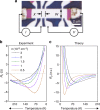Fluidity onset in graphene
- PMID: 30382090
- PMCID: PMC6208423
- DOI: 10.1038/s41467-018-07004-4
Fluidity onset in graphene
Abstract
Viscous electron fluids have emerged recently as a new paradigm of strongly-correlated electron transport in solids. Here we report on a direct observation of the transition to this long-sought-for state of matter in a high-mobility electron system in graphene. Unexpectedly, the electron flow is found to be interaction-dominated but non-hydrodynamic (quasiballistic) in a wide temperature range, showing signatures of viscous flows only at relatively high temperatures. The transition between the two regimes is characterized by a sharp maximum of negative resistance, probed in proximity to the current injector. The resistance decreases as the system goes deeper into the hydrodynamic regime. In a perfect darkness-before-daybreak manner, the interaction-dominated negative response is strongest at the transition to the quasiballistic regime. Our work provides the first demonstration of how the viscous fluid behavior emerges in an interacting electron system.
Conflict of interest statement
The authors declare no competing interests.
Figures





References
-
- Damle K, Sachdev S. Nonzero-temperature transport near quantum critical points. Phys. Rev. B. 1997;56:8714–8733. doi: 10.1103/PhysRevB.56.8714. - DOI
-
- Forcella D, Zaanen J, Valentinis D, van der Marel D. Electromagnetic properties of viscous charged fluids. Phys. Rev. B. 2014;90:035143. doi: 10.1103/PhysRevB.90.035143. - DOI
Publication types
LinkOut - more resources
Full Text Sources

